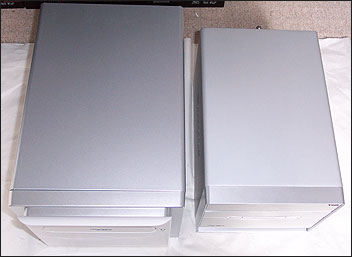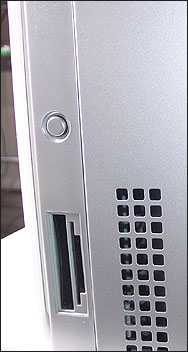Exterior
I'll get the size issue out of the way first. It's a big bugger, moreso than the P-series and especially moreso than the G-series XPCs. Here's a shot of the SB86i next to a G5-variant XPC (which I'll be reviewing soon).You can see it's obviously larger in the depth and width dimensions, and it's also fair bit higher to boot. The front of the chassis sticks out a bit on the i-Series, creating something which Shuttle call the i-Panel. On the SB86i, it's iMac-like white plastic and the i-Panel has a lip at the top, which hints at you being able to carry it using that lip as something to grasp, whereas in reality you shouldn't do anything of the sort.
It's a steel chassis, with the steel lid a silver colour that looks much more impressive in Shuttle's press photography than it does in person, or in photos in reviews like this. It's painted that way to give the impression of being aluminium, from the looks of things, but it falls slightly short if that was their intention. You'll get a better look from the front.
At first glance you'd expect the cutout at the top of the facia to be the opening for a slim-line optical drive, but you'd be wrong. It's cosmetic only, letting the light from an LED light-bar shine through, to indicate power and disk activity. It glows the standard blue when switched on and lightly flickers when any of your internal storage devices are accessed.
The rounded panel with the XPC logo on is the stealthed optical drive bay cover. With a drive installed behind it, push the button next to the cover to have the tray of the drive slide out, so you can pop a disk in or out. I'm not sure what you think, but to me the iMac/iPod-style aethetic is pleasing enough. Shiny matt white plastic isn't to everyone's tastes, though. The eagle-eyed among you will have spotted the lack of power or reset buttons on the front. Instead, they're just round the corner, on the right.
The power button sits a short distance above the multi-format card reader that Shuttle have embedded in the side of the XPC chassis front. The formats supported by the device are labelled nearby, on the front-facing section of the chassis. On the left side of the unit you've got serial bus expansion ports and audio connectors.
Two USB2.0, a FireWire400 port and headphone and mic connectors ride that side of the chassis front. Notice the cutouts on both sides, both in the cover and round the side of the i-Panel assembly. They're for cooling, more on which later.
The unit's 240mm width is most apparent at the rear, an 80mm cooling fan exhausting air from the PSU not dominating proceedings like it would on a P-series or smaller XPC.
You can see a cutout at the top of the rear of the unit for a parallel port, nestling above the female power cord connector you use to give the SB86i some juice. Two I/O backplane slots hog the left side and a packed I/O shield area shows off Shuttle's FB86 picoBTX mainboard's connectivity opportunities. There's VGA output from the GMA900 graphics with a serial port above it.
Why isn't there a DVI output instead? If not to complement the analogue D-sub connector by replacing the serial port, but even to replace the analogue output completely, to which you could just attach a bundled convertor? Given the horrid filters Shuttle use for the GMA900's analogue connector, DVI would have been a much better choice as the default display connector. The analogue output goes to pot above 1024x768 at any kind of sane refresh rate, on a CRT monitor. Urgh.
The large amount of cutouts at the rear are for ventilation. Being BTX, the internal layout is largely based on logical, more effective cooling, partitioning the interior into zones. The cutouts at the rear allow the front-to-back airflow of BTX to work. More on that in a while.
Powered FireWire400 sits to the left of PS/2 for mouse and keyboard, and a tiny button to clear CMOS slides alongside those. To use it you power off the XPC fully, turning off at the mains, before pressing and holding the small button with the tip of a pen or pencil for a few seconds. That clears the CMOS memory, so when you next power up the system you can get back into the BIOS interface and redo your settings. Not having to open up the chassis to reset that is a must on a cramped small-form-factor system. Indeed, the feature should be available on absolutely all mainboards, regardless of form-factor.
The USB2.0 port pairing and Gigabit Ethernet port are next, followed by the myriad of audio connection options, the most notable of which are the Toslink S/PDIF optical digital I/O ports, for connecting to a suitable receiver or amp. Whether it's round the back or up at the front, there's something for you to interact with on the SB86i.
Summary
The overall aesthetic is better in pictures than it is up close, if you ask me. I'm not a fan of the faux-aluminium as much as I am a fan of the Apple-inspired i-Panel. The white front is on the right side of the tacky/tasteful divide. Well, it is for me at least. However, I've had people round to see me recently that have come up to my office where they've seen the SB86i up close on my testing area, and the majority aren't that impressed, especially when placed next to a G-series XPC. Most don't like the size and most are unimpressed with the white frontal area and side-mounted ports, slots and buttons.Fancy a peek under the covers?














